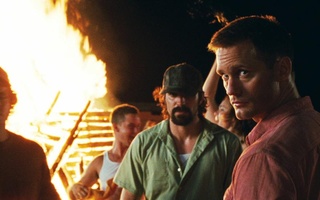Do you like the Spice Girls? The men of “DOGS” do, and they took the song to places one would never expect. “DOGS,” which ran until Saturday in the Loeb Ex, was an updated, live-theater version of Quentin Tarantino’s 1992 film “Reservoir Dogs,” a chilling fall into the pit of armed robbery. The transition from film to theater is often a tricky one because the director loses the ability to edit and use zoom or special effects. Though sometimes weakened by the new form, the adaptation by director Sam S. Richman ’15 used the advantages of live theater as well as superb acting, and excellent design to make the production stand on its own as a play.
Indeed, most aspects of the story actually came across better on stage than on film. Nini’s ’90s radio station, an updated version of the ’70s soundtrack used in the movie, tied the fragments of plot together, and instead of a blank screen as a transition, “DOGS” made Nini (Simone E. Polanen ’14) at her DJ station a focal point to accompany set transitions. Sound designer James B. Pollack ’14 also let the songs provide a musical backdrop for the show’s action. The music was as much a part of the design as the the lights or the warehouse in which most of the production took place. The Backstreet Boys’ “I Want It That Way” was juxtaposed against a torture scene, and other ’90s hits were used as settings both seriously and ironically. Audience members were even able to text in song requests during intermission, which allowed for more interaction with the performance.
Richman incorporated many aspects into his production that created a genuine Tarantino aesthetic. He made a cameo as Mr. Brown, an unimportant gang member who appeared in only a few scenes, as Tarantino did in his film. The warehouse, designed by Zena M. S. Mengesha ’14, was in keeping with the tone of the original film; it was stark and spare, while lights designed by Alice F. Hyde ’16 and Adam O. Brodheim ’16 brought out the roughness of the set. A single blue light washed the stage with an icy glow, and the spot that lit up Nini’s corner on the balcony was enough to separate the spaces while highlighting the action.
The acting was strong across the board, each performance different enough from the iconic Tarantino ones to give “DOGS” a fresh feel. The good guys were well-developed characters, but it was really the men in suits who stood out. Benjamin J. Lorenz ’14 made the act of dying from a stomach wound into an art; with no film tricks to rely on, he did an admirable job of conveying unbearable pain—for almost an hour. Mr. White (James C. C. Butler ’15) set the tone of the show as a hardened antihero who asks whether an aggressively neurotic Mr. Pink (Jonathan J. S. Longcroft ’15) killed “any real people,” as opposed to cops. Andrew N. Shindi ’13 was appropriately threatening yet fatherly as Joe Cabot, and his incompetent son Eddie was played by a fun, bouncy Taylor A. Cressler ’14. However, it was Daniel J. M. Hilhorst ’15 who stole the show as the psychopathic Mr. Blonde, terrifyingly laid back instead of homicidally cold.
Unfortunately, the fight choreography by Matthew W. G. Walker ’16 could not live up to the cinematographic expertise required for such a violent, threatening show. Simpler fight scenes with punches and kicks just did not quite seem to work on the stage, and the palpable conflict often disappeared when physical fights were involved. Blood abounded, but it was ultimately unconvincing—a detached ear looked so fake that much of the horror was lost.
Aside from the occasionally fake portrayal of violent scenes, the lack of set and design contrasts possible in a small theater caused the performance to suffer during flashback scenes. Though Joe’s office was meant to be the den of the mafia don, it just looked sad and empty. Likewise, a bedroom, a train bathroom, and a bar were ultimately unconvincing because the set was not entirely realistic nor minimal, but instead an uncomfortable compromise. The best of the flashbacks was Mr. Pink’s recollection of running from the shootout at the jewelry store, as it used no set change or props, but instead was separated by lights, sound, and clear acting. When “DOGS” embraced the stage instead of imitating the film it was more successful in making the complicated transitions clear.
The transformation of “DOGS” into a stage play succeeded because of the largely good design, effective use of sound and music, and excellent group of actors. As morally ambiguous as the original, “DOGS” added attitude and youth to the original premise. From the beginning of the show, when the actors strode through the waiting crowd outside the Loeb Ex, they immersed themselves in their characters and emphasized the best aspect of a live theater adaptation—being in the room with “the professionals” instead of viewing them through a screen.
—Staff writer Sara Kantor can be reached at skantor@college.harvard.edu.
Read more in Arts
Look Out, World: K-pop Acts Worth WatchingRecommended Articles
-
 Sit, Stay, Go Away
Sit, Stay, Go Away -
 'Straw Dogs' is Too Coarse for Comfort
'Straw Dogs' is Too Coarse for Comfort -
Coordinates: Off the LeashEven if Libby and I have different ideas of what a “walk” entails, we both love our visits to Manor ...
-
 Dog Days (Literally) of Atlanta
Dog Days (Literally) of Atlanta -
 J-Term Journal: Dog Sledding
J-Term Journal: Dog Sledding -
 Kluge, Not Clooney: Two Movies to Watch Instead of "The Monuments Men"
Kluge, Not Clooney: Two Movies to Watch Instead of "The Monuments Men"













